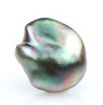Given that cultured pearls are natural organic gems, they exhibit in a number of shapes, each with its own unique characteristics. No two pearls are exactly alike and every pearl presents in a slightly different shape. The shape of the pearl is one of several factors that determine its quality and value. In all pearl types, round pearls are the “classic” shape and generally the most valuable and sought-after shape. Perfectly spherical pearls, though, are the rarest of cultured pearls. Combined with good quality nacre and superior luster, they command the highest prices in the pearl market.
The shape of the pearl depends largely on the shape of the inserted nucleus. As the pearl grows slowly inside the mollusk, nacre is deposited around the bead-nucleus. If the bead is round, the resulting pearl will most likely reflect this shape. It is worthwhile to keep in mind, however, that the culturing period is somewhere between 16-24 months. Other factors that affect pearl shape will certainly come into play like ocean currents, the quality of the nucleus, the handling of the mollusks (they are suspended in lines or baskets and removed from the water to be cleaned regularly during their growth period), water temperature and salinity, and the purity of the marine environment from whence they are expected to thrive. These factors do not affect pearl shape alone but the overall quality of the pearl.





